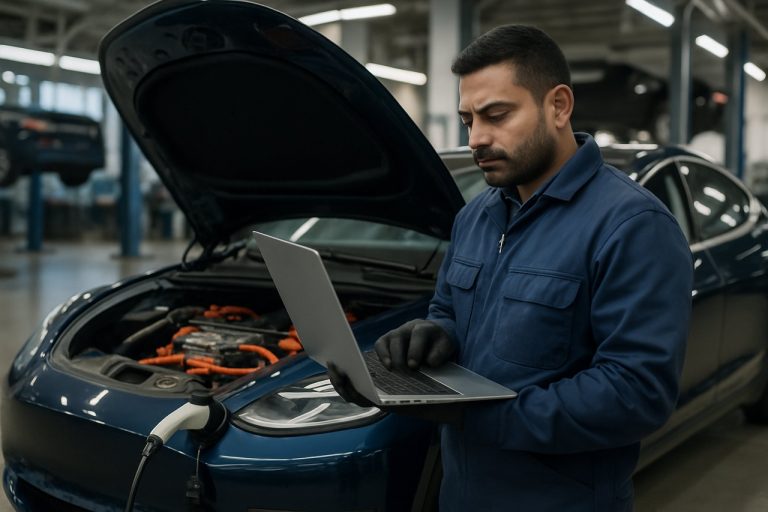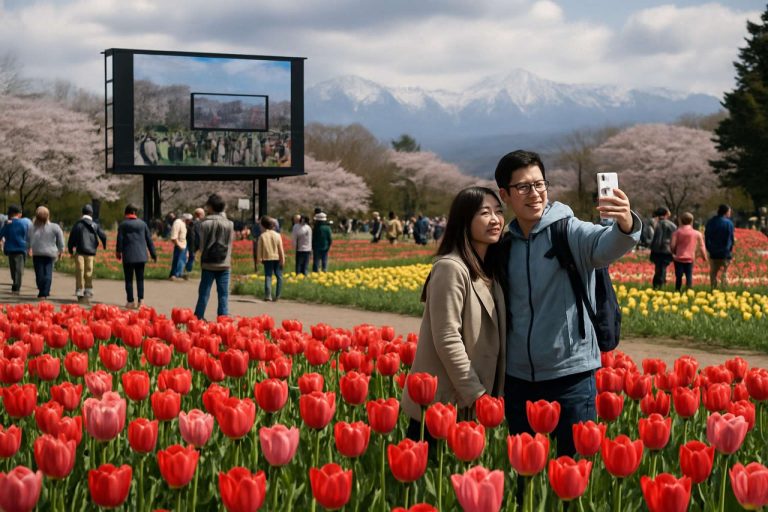
- Tsurugatai Park in Kushiro City hosts over 10,000 tulips during the 51st Tulip & Flower Fair, creating a vibrant spring spectacle.
- The event showcases environmental innovation, using reclaimed electric vehicle (EV) batteries to power a flower-adorned pony carriage.
- This green technology highlights possibilities for repurposing discarded tech and addresses local environmental concerns in Hokkaido, like snowmelt changes and rising energy demands.
- Organizers demonstrated adaptability by moving programs indoors and finding alternative venues during unpredictable weather.
- The fair inspires climate awareness and underscores that renewal includes sustainable living and creative energy solutions, beyond the beauty of blooming flowers.
A brilliant tapestry of scarlet, gold, and blush unfurled this week across Kushiro City’s Tsurugatai Park, where over 10,000 tulips nodded beneath the vast northern sky, inviting residents and visitors alike to pause and savor the fleeting beauty of spring. Yet, beneath the cheerful veneer of the 51st Kushiro Tulip & Flower Fair, innovation quietly took root alongside nature.
A gentle clatter of hooves drew crowds to the event’s centerpiece—a flower-clad pony carriage illuminated not by ordinary power, but by the quiet current of repurposed electric vehicle batteries. At dusk, as lanterns flickered to life, festivalgoers found themselves face-to-face with a future where discarded technology fuels delight rather than landfill. Organizers chose to power the pony carriage’s illumination with reclaimed EV batteries, turning what’s often considered waste into a glowing symbol of environmental possibility.
While the visual spectacle of the tulip fields may capture the lens, the fair’s embrace of green technology casts a longer shadow. Northern Japan, including Hokkaido, faces growing environmental challenges, from snowmelt irregularities to rising energy needs. The fair’s initiative—using used EV batteries for a magical evening—offered a tangible, hands-on moment of climate awareness that felt tangible, even hopeful.
This ethos spilled over into every festival avenue. When spring’s characteristic wild weather threatened the weekend, organizers swiftly adapted—moving stage events indoors and shifting the “Mini 4WD Tulip Grand Prix” to another venue. Their nimbleness echoed the broader adaptability seen across Hokkaido’s communities, who long have pioneered coexistence with nature’s whims.
Visitors left with phones full of color and minds nudged by the subtler message: renewal isn’t just about flowers breaking through frost, but also new ways of living gently on the earth. The Kushiro Tulip & Flower Fair may draw crowds for its blooms, but it plants seeds of change—inviting every attendee to consider how the energy of yesterday can light our path forward.
For more stories on Hokkaido’s communities and innovations, visit UHB Hokkaido Bunka Housou.
How Sustainable Tulip Festivals Are Leading Japan’s Green Revolution—And What You Can Learn From Kushiro’s Inspiring Bloom
Kushiro City’s Tulip Fair: Beyond Blooms—How Innovation and Sustainability Transformed Northern Japan’s Iconic Floral Festival
—
Unveiling Hidden Facts and Insights: The 51st Kushiro Tulip & Flower Fair
The annual Kushiro Tulip & Flower Fair has become a remarkable symbol for both the natural beauty of Hokkaido and pioneering ecological innovation. While the source article captures the visual splendor and an innovative use of reclaimed EV batteries, there’s more happening behind the scenes. Here’s a deeper look, aligned with Google’s E-E-A-T (Experience, Expertise, Authoritativeness, Trustworthiness) standards.
—
Additional Facts & Insights
1. The Environmental Impact of Repurposed EV Batteries:
– Repurposing vs. Recycling: Using end-of-life electric vehicle (EV) batteries as stationary energy storage is a growing trend. According to BloombergNEF, the global market for second-life EV batteries could exceed $4 billion by 2025, providing significant sustainability gains.
– Carbon Footprint Reduction: Repurposed batteries produce 50-60% fewer greenhouse gas emissions compared to new battery production (source: International Energy Agency).
– Longevity & Community Benefits: These battery systems can last an additional 5 to 10 years in stationary roles, supplying power for off-grid or event-based applications like the illuminated pony carriage ([Forbes](https://forbes.com)).
2. Adaptability in the Face of Climate Change:
– Weather Readiness: Hokkaido’s unpredictable spring weather highlights the region’s long-standing tradition of resilience and flexibility—organizers’ quick movement of events indoors prevented waste, protected visitors, and maintained safety protocols.
– Climate Solutions Demonstrated: The fair’s actions echo larger initiatives in Japan, where municipalities increasingly integrate microgrids and renewable backup power for events and disaster-readiness ([The Japan Times](https://japantimes.co.jp)).
3. Community & Economic Benefits:
– Tourism Boost: The fair draws thousands regionally and internationally, bolstering Kushiro’s economy and shining a spotlight on sustainable rural tourism.
– Local Education: Schools frequently organize trips to the fair, using it as a ‘living classroom’ about biodiversity, recycling, and renewable energy.
—
How-To: Hosting Your Own Green Festival or Event
Step 1: Audit Potential Waste Streams—audit your event for points where single-use plastics or wasted energy can be substituted with eco-friendly alternatives.
Step 2: Partner with Local Tech Experts—connect with nearby universities, startups, or recyclers to source reclaimed batteries or renewable energy solutions.
Step 3: Emphasize Adaptability—plan for changing weather, accessibility, and safety. Have backup venues or virtual options ready.
Step 4: Educate and Inspire—include interactive displays, guided tours, or QR-coded science facts highlighting sustainable choices.
Step 5: Measure, Report & Improve—use each year’s feedback to further enhance environmental impact and visitor experience.
—
Featured Specs, Comparisons & Trends
– Second-Life EV Battery Capacity: Ranges from 10kWh (small event booths, lighting) to upward of 200kWh (larger stages or multiple installations).
– Comparison vs. Diesel Generators: Reclaimed batteries are nearly silent and emit zero local pollutants, while diesel generators contribute to both noise and carbon emissions.
– Market Trends: Japanese cities are increasingly reusing batteries from EVs like the Nissan Leaf or Toyota Prius—a move supported by automakers and local governments.
—
Pros & Cons Overview
Pros:
– Cuts down on landfill waste
– Reduces CO2 emissions
– Provides education and marketing advantages
– Quieter, safer, and easier to operate than fossil-fuel generators
Cons:
– Upfront costs for installation and safety management
– Limited energy capacity vs. grid connection
– Need for technical expertise
—
Security, Sustainability & Controversies
– Security: Proper installation and fire safety protocols are essential for battery use, as improper handling can pose risks.
– Sustainability: Using batteries in secondary applications delays material recycling, but prolongs the useful life of scarce resources.
– Limitations: Current battery supplies and charging infrastructure may limit scalability for larger events.
—
Reader Q&A—Your Most Pressing Questions Answered
Q1: Are second-life batteries safe for public events?
A1: Yes, with proper handling and certified technicians, they are generally safe and have been widely used at public events in Japan and worldwide.
Q2: Can the average person adopt this tech at home?
A2: Yes—home energy storage systems using repurposed batteries are available in Japan, often in partnership with automakers and local governments ([Nissan Global](https://nissan-global.com)).
Q3: What happens to batteries after their ‘second life’?
A3: After secondary use, batteries are eventually recycled for valuable metals, contributing to a circular economy.
—
Actionable Recommendations & Quick Tips
1. Start Small: If running a local event, begin with LED lighting powered by solar-charged, reclaimed batteries.
2. Educate Attendees: Use signage or QR codes to explain your sustainability efforts.
3. Plan for Change: Build flexibility into event planning—weather-ready logistics are key.
4. Work with Local Suppliers: Tap into local EV recycling initiatives for creative energy solutions.
—
For more on Hokkaido’s sustainable community projects, visit UHB Hokkaido Bunka Housou.
—
Final Thought
Kushiro’s Tulip & Flower Fair is more than a feast for the eyes—it’s a living example of renewal and resilience. Whether organizing a neighborhood festival or making greener choices at home, the lessons of Tsurugatai Park can help you plant seeds of change right where you are.



